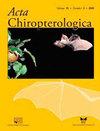Interaction Networks between Bats (Mammalia: Chiroptera) and Ectoparasitic Flies (Diptera: Hippoboscoidea) in the Colombian Orinoquia Region
IF 0.7
4区 生物学
Q4 ZOOLOGY
引用次数: 1
Abstract
The study of host-parasite interactions is key to understanding ecological interactions since parasites play a crucial role in the regulation of populations of host species. The families Nycteribiidae and Streblidae (Diptera: Hippoboscoidea) are ectoparasitic flies specific to bats, which have evolved adaptations to their host. The host-parasite interactions are formed by coevolutionary processes and illustrate the current and historical associations between the species involved. For this reason, the use of ecological networks in parasite-host interactions allows us to elucidate how the structure of their interactions respond to biotic and abiotic factors. In the present study, we evaluated changes in the fly-bat interaction networks in two contrasting landscapes in the Department of Arauca of the Colombian Orinoquia Region. The first landscape is composed of savannas and alluvial forests and the second with anthropogenic disturbances composed of cocoa crops, livestock areas and human settlements. We used mist nets to capture bats and collect their respective parasitic flies. Using this data, we built a bipartite interaction network for each landscape, and we calculated the main metrics of each network. 19.8% of the 524 bats captured presented ectoparasitic flies, with a total of 326 flies belonging to nine genera of Streblidae and one genus of Nycteribiidae. The diversity and prevalence of ectoparasitic flies of bats was higher for the disturbed landscape in contrast to savannas and forests. The networks of both landscapes were characterized by being highly specialized and modular. Nonetheless, the network obtained in the savannas and alluvial forests showed greater specialization, and the landscape with anthropogenic impact presented greater modularity. Our results confirm the high specialization and modularity that characterizes the ectoparasitic bat-fly antagonistic network. Also, we provided new observations suggesting that a degraded landscape may affect the bat hosts and favors overcrowding and, consequently, the exchange of ectoparasites between bat species, reducing the level of specialization and promoting the increased prevalence of bat ectoparasitic flies.哥伦比亚奥里诺基亚地区蝙蝠(哺乳动物:翼手目)和寄生蝇(直翅目:Hippoboscoidea)之间的相互作用网络
宿主-寄生虫相互作用的研究是理解生态相互作用的关键,因为寄生虫在宿主物种种群的调节中发挥着至关重要的作用。Nycteribidae和Streblidae(直翅目:Hippoboscoidea)是蝙蝠特有的外寄生苍蝇,它们已经进化出适应宿主的能力。宿主与寄生虫的相互作用是由共同进化过程形成的,说明了所涉及物种之间的当前和历史联系。因此,在寄生虫-宿主相互作用中使用生态网络使我们能够阐明它们相互作用的结构如何对生物和非生物因素作出反应。在本研究中,我们评估了哥伦比亚奥里诺基亚地区阿劳卡省两个对比鲜明的景观中飞蝙蝠相互作用网络的变化。第一个景观由稀树草原和冲积林组成,第二个景观由可可作物、畜牧区和人类住区组成的人为干扰。我们用雾网捕捉蝙蝠并收集它们各自的寄生苍蝇。利用这些数据,我们为每个景观构建了一个二分交互网络,并计算了每个网络的主要指标。在捕获的524只蝙蝠中,19.8%呈现外寄生苍蝇,共有326只苍蝇属于Streblidae的9个属和Nycteribidae的1个属。与稀树草原和森林相比,受干扰景观中蝙蝠外寄生蝇的多样性和流行率更高。这两个景观的网络都具有高度专业化和模块化的特点。尽管如此,在稀树草原和冲积林中获得的网络表现出更大的专业化,具有人为影响的景观表现出更高的模块化。我们的研究结果证实了外寄生蝙蝠-苍蝇拮抗网络的高度专业化和模块化特征。此外,我们提供了新的观察结果,表明退化的景观可能会影响蝙蝠宿主,并有利于过度拥挤,从而导致蝙蝠物种之间的体外寄生虫交换,降低了专业化水平,并促进了蝙蝠体外寄生虫蝇的增加。
本文章由计算机程序翻译,如有差异,请以英文原文为准。
求助全文
约1分钟内获得全文
求助全文
来源期刊

Acta Chiropterologica
生物-动物学
CiteScore
2.50
自引率
20.00%
发文量
42
审稿时长
>12 weeks
期刊介绍:
Acta Chiropterologica, published by the Museum and Institute of Zoology at the Polish Academy of Sciences, is devoted solely to the study and discussion of bats.
 求助内容:
求助内容: 应助结果提醒方式:
应助结果提醒方式:


